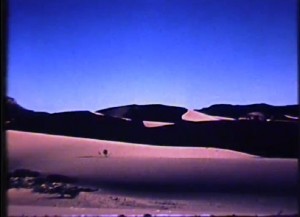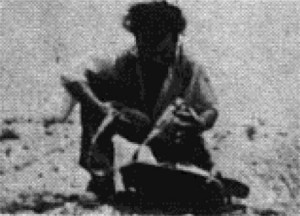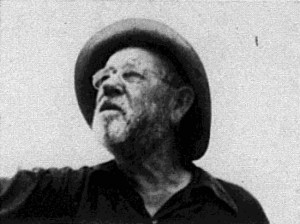
"O.L. Tapp has coupled opportunity and imagination in putting motion pictures to the recording "Shifting Whispering Sands." Finding the right kind of material to photograph must have entailed a great deal of planning and searching. Every scene is a work of art. As one watches the scenes unfold to the music and song he feels compelled to sit in contemplation of the lonesomeness of the great desert." PSA Journal, Nov. 1957, 33.
"EL TERCER SUSPIRO. Separa de un grupo de paseantes en la Alameda a un joven que al aceptar la invitación a subir a un auto que le hacen tres desconocidos (identificados con el movimiento revolucionario de 1910, mediante un montaje de fotografías de la época), durante el paseo por el Periférico se ve acometido por una serie de evocaciones imaginarias. Primero se le ve huir del coche saltando a un paso de peatones, y ser acosado a través de casas derruidas. Al regresar al tiempo presente uno de los hombres le pone la mano en un revólver. Después se ve en un lugar desierto, penosamente sostenido en pie por un aparato ortopédico, mientras una marea creciente lo empieza a cubrir. En ese punto desciende del coche en marcha y se coloca en el centro de la carretera, amenazando con el arma a algo que se aproxima; pero antes de que se produzca el disparo evoca un encuentro amoroso. Esta acción se repite varias veces antes de disolverse en las imágenes de un lago que ahora lo ha cubierto todo"(Garmendia en Vázquez Mantecón, 2012).
"THE THIRD SIGH. Separates a young man from a group of pedestrians in the Alameda, when he accepts an invitation by three unknown men to get into a car (the men were identified with the revolutionary movement of 1910 through a photographic montage of the time), during the ride through Periférico, he is undertaken by a series of imaginary evocations. First he is seen running away from the car, jumping to a crosswalk, and being harassed through demolished houses. When coming back to the present, one of the men puts his hand on a revolver gun. Afterwards, he is seen in a desert place, shamefully sustained by an orthopedic device, while a rising tide starts to cover him. At this point he descends from the moving car and goes to the center of the highway, menacing with his gun something that is approaching; but before the shot is produced, a loving encounter is evoked. This image is repeated several times before dissolving into images of a lake that has now covered everything" (Garmendia in Vázquez Mantecón, 2012).

"The zest for gold can impose a hardship upon one so fortunate as to find the metal. The prospector in this film chose the desert for his search, and with success until he realized that he was lost and without water. Another prospector happened by with a canteen of water. In the desert, the price of water can be very great as this thirsty prospector learned to his chagrin" PSA Journal, Oct. 1962, 36.
"Glen H. Turner brings to us the song of the desert and the water wheel that turns continuously. We move from the melting snows on to the streams, lakes and rivers. The churning rivers, increasing in power and rhythm, brown with the soil of the desert, the power for the water wheel. The slow, great turning water wheel pours forth the brown water, the life of vegetation in the gray hills, casting its shadow, its red shadow in the setting sun" PSA Journal, Nov. 1958, 46.

"Kyle Holmes has also turned his camera toward the recording of Shifting Whispering Sands and has used scenes of the desert country to blend with the old desert character. This film is less critical in the use of scenes, leaving to the imagination the privilege of filling in some of the details. It is most unusual that two almost identical films are entered in the same contest. It happened here and the two films were rated as almost equal" PSA Journal, Nov. 1957, 53.
Total Pages: 2